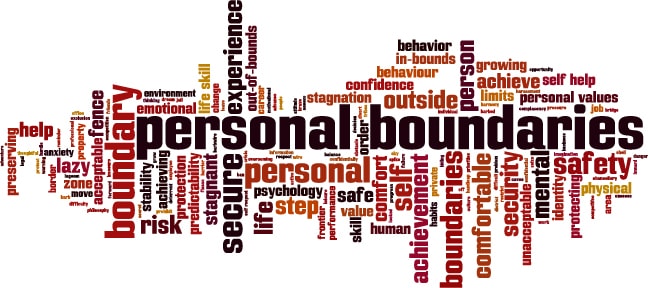Have you ever felt like your personal space has been invaded or that someone is taking advantage of you? These are red flags that indicate the need for setting clear boundaries in your relationships. Boundaries create a safe and respectful environment where individuals can thrive personally, emotionally, and professionally.
In this blog post, we will cover the different kinds of boundaries, why it is essential to communicate our boundaries effectively, and how to prepare for any challenges that may arise. We will also share tips on how to say “no” when necessary and become aware of other people’s boundaries. By reading this article, you will have a better understanding of how to establish and maintain healthy boundaries in all of your relationships.
Please note that this article is geared toward individuals who have a relatively good level of mental health. While boundaries are a problematic issue in relationships with people who are narcissistic or who have borderline personality disorder, this article does not address that level of dysfunction.
Different Kinds of Boundaries
There are different types of boundaries and the ones we will discuss here include relationship, personal, and identification boundaries. While some of these may overlap, it’s a good idea to begin with some fundamentals.
1. Relationship Boundaries
Relationship boundaries refer to the limits and rules that we set for ourselves in different kinds of interpersonal relationships, including romantic relationships, friendships, family relationships, and professional relationships. Within each relationship there are do’s and don’t’s that need to be defined and clear for ourselves as well as others.
For instance, at work, we have certain expectations when it comes to boundaries with co-workers and bosses. These may include limits on personal conversations during work hours or maintaining a professional demeanor while interacting with colleagues. On the other hand, our boundaries with family can be more relaxed and intimate, allowing for open communication and emotional support.

Establishing and maintaining healthy relationship boundaries is crucial to building strong and fulfilling connections with others. It helps to foster mutual respect, trust, and understanding between individuals.
These boundaries include the way we allow others to speak to us and the way we choose to speak to others. The more defined and clear we can be about what is acceptable and what is not, the better able we will be to communicate to others our boundaries within each relationship.
2. Personal Boundaries

Personal boundaries play a significant role in a healthy mindset. They are parameters that we set for ourselves as to how we want to be treated by others.
As we develop our personal boundaries, we learn to trust our instincts about what makes us feel safe and what doesn’t. For example, I was traveling alone through a busy airport and needed to take a shuttle to my hotel. At the shuttle pickup location, a man asked me what hotel I was staying at. I tried to ignore him, but he was persistent. I told him quietly the name of my hotel. I didn’t want everyone in line knowing my personal business. Was I being rude? The man was harmless, but I felt the need to protect myself from sharing too much information. I was a female, alone, in a strange and large city. I was tired and not feeling comfortable or safe. I made a point to move away from him so that he wouldn’t continue any kind of conversation that would leave me feeling vulnerable to those around me.
Gaining clarity of personal boundaries helps us to gauge how close we want another person to be to us. Within each relationship, we have certain levels of comfort in regard to proximity. Some people are huggers and some just aren’t. It’s a good idea to trust your comfort level in each relationship when it comes to physical distance and affection. Even in professional relationships, physical proximity can vary. For example, you may hug your hair stylist, but you probably don’t hug your dentist.

Personal boundaries help us to communicate our likes and dislikes clearly, which can prevent misunderstandings and conflicts within relationships. While it’s not always easy to communicate our boundaries, finding the right words really helps others to understand us better. For example, if your friend says something derogatory toward you, let her know not only that it bothered you, but explain why it bothered you. Take a breath and use words that truly describe how you feel. It’s important to be clear and use phrases that express your feelings instead of accusing the friend of being rude or wrong.
Some examples could be: “I need to share with you why that bothered me.” or “It may seem like nothing to you, but your words hurt me.”
By communicating clear boundaries to others, you allow them to gain a sense of their own individuality and their own responsibility within the relationship, which leads to healthier and more fulfilling relationships.
3. Identification Boundaries
Identification boundaries help us clarify our own interests, likes, and dislikes. In close relationships, such as marriages, lifelong friendships, and partnerships, boundaries can become murky over time. We tend to take on the other person’s habits or tastes in life. For example, before I married my husband, I never listened to country music. I didn’t dislike it, I was just more into other genres. And now, while I’m not a consistent country music listener, I’ve come to enjoy his play list from time to time especially as we are doing projects around the house.

Identification boundaries also help us to clarify what makes us comfortable and what makes us uncomfortable. For example, when someone with whom you are in relationship tries to manipulate you into doing something that you honestly do not want to do, it’s important to take responsibility for your own choices. It’s a good idea to keep in mind, that you are not responsible for the other person’s feelings when they are asking you to do something that you clearly are not comfortable doing.
Identification boundaries also helps us to be clear about our choices when it comes to acquaintances. For example, if a person asks you to take on a responsibility and you are truly not comfortable or willing to take it on, be clear about saying no thank you. It’s best not to give excuses, just say that it’s not the right time or that you are not comfortable with the task/responsibility. Typically when we tell someone no, we experience a certain amount of guilt or fear that the other person will not like us. That’s normal. We might have to take the risk of being disliked in order to be true to ourselves and to take care of our own mental health.

We all know someone who takes on the weight of the world, and while she is a good person at heart, she is typically overwhelmed by her life. She just may not show it! Identification boundaries give us a guideline for saying no when we need to while managing any feelings of guilt. These guidelines help us to be clear about when we can help someone and when we cannot. Keep in mind that as we act on our identification boundaries, we come to respect others’ boundaries as well. We become less offended when someone says no to us.
Identification boundaries help us to identify what is within our control and what is not. To be clear, we don’t have control over another person’s behavior or feelings. And while there are many difficult people in the world, the more we realize that we have little to no influence or control over another, the easier it will be to let go of people who are too demanding and manipulative.
In addition, identification boundaries also help us define who we are and who we want to become. By setting clear boundaries around our own identity, we can more easily navigate relationships with others and ensure that our needs are being met in a healthy way. Ultimately, establishing and maintaining healthy identification boundaries is essential for building strong and fulfilling relationships in all areas of life.
Importance of Communicating Our Boundaries to Others
Boundaries are not just about establishing limits on what we will or will not do in a relationship; they’re also about making sure that those around us understand and respect those limits. Finding the right words to express our boundaries to others is key.
It’s also important to avoid engaging in activities that put our boundaries at risk, and communicate to others when we feel uncomfortable or threatened by their behavior. If our boundaries are violated, it is our responsibility to take steps at correcting the situation using our communication skills in order to prevent the situation from escalating.
How to Communicate Our Boundaries
Once we have defined our boundaries, it’s important to communicate them to others as clearly and respectfully as possible. This can be a difficult process, as it may involve potentially hurting someone’s feelings or letting them down. However, not communicating our boundaries can lead to resentment and ultimately damage the relationship.

One crucial aspect of this communication is to be clear and concise. It’s not helpful if we are vague or meek in how we share this information. As we explain to someone what our boundaries are, it’s natural to feel vulnerable and awkward. However, in order to avoid misunderstandings, we must do our best at conveying what our limits are. It’s worth a few moments of awkwardness in order to avoid feelings of resentment or fear.
Some statements that may be useful are:
“I’m only able to meet you at the cafe. I cannot come pick you up again.”
“I know you don’t like rom-coms, so I’m going with Anita.”
“I can babysit again, but only on Saturday afternoons between 1 and 6.”
“I’m not able to do that anymore. It’s not healthy for me.”
“It’s important to me that you understand how I feel.”
“While this may put you in a bind, I cannot watch your dog. I’m afraid of him.”
“A healthy lifestyle is becoming more important to me and because of that, I can no longer buy processed foods at the grocery store.”
These are just a few examples of the many situations we find ourselves in when we can and should express our boundaries.
Another aspect to effectively communicate your boundaries is to make sure you are clear about what your limits are and why they are important to you. Use “I” statements rather than blaming or using defensive language. Be open to hearing the other person’s perspective and to the possibility of finding a compromise that works for both of you. Remember that setting and communicating boundaries is an ongoing process and may require reassessment over time.
Being confident and calm during the conversation is essential. Using a mantra or positive self-talk can help manage any anxiety or nervousness that may arise. By following these tips, individuals can effectively communicate their boundaries to others and establish healthier relationships.
Boundaries – Not Always Easy
Establishing and maintaining healthy boundaries in relationships is crucial for creating a respectful and fulfilling partnership. However, communicating our boundaries to others can be a challenging process, especially when we are feeling angry or upset. It can also be difficult to know what is acceptable to our partner; fear of rejection may arise.
Despite the challenges, it is important for both parties to communicate their boundaries openly and honestly. When we fail to do so, the situation may become tense and unhealthy. Effectively communicating our boundaries requires patience, empathy, and active listening skills. By doing so, we can feel confident in trying to establish mutual respect in the relationship and ensure that both partners feel comfortable with the resolution.
Prepare for Challenges
Establishing and maintaining healthy boundaries in relationships can be challenging. It is important to stay aware of your own mental health and set realistic expectations for yourself and others. Visualizing a successful outcome can help motivate you to work towards establishing those boundaries.
Preparing a sentence or phrase that helps clarify your boundaries for others can also be helpful. Practice with people who understand and support you, as this can build your confidence in asserting your needs. Remember to be patient with others as they may need time to adjust to your new boundaries. With time, effort, communication, and patience, healthy boundaries can be established and maintained in relationships.
Boundaries of Others
Setting boundaries in relationships is not just about defining your own limits, but also being aware of others’ boundaries. It’s important to listen to others when they are expressing their comfort level and to come to understand what may be uncomfortable for them. Showing them respect for their wishes and limits is good for both of you.
Taking time to listen carefully to their needs and desires, being considerate of their feelings, and avoiding behaviors that could cause them discomfort shows your own level of mental health. By becoming more aware of others’ boundaries, you can build stronger, more respectful relationships based on mutual trust and understanding.
Acknowledge Others
When others show you respect for your boundaries, it’s important to acknowledge their actions. A simple “Thank you” can go a long way in helping others see how this boundary is important to you. Expressing gratitude can help reinforce understanding of the boundaries in your relationships. Remember that everyone is different, so it’s important to listen to and respect the needs of others as well as your own.
One More Thing About Saying “No”
There are many times when we need to say “no”. These may include declining an invitation, letting someone know that we won’t be able to do something, or simply when we don’t want to do something that someone is asking us to. When we find ourselves wanting to say “no”, we can take a pause. Ask for clarification. Ask for time to think about their request. Even if we think we might say “yes”, take a pause. Doing this helps us be more mindful about our limits and boundaries.

By using these techniques, you can set clear boundaries while still maintaining positive relationships with those around you. Remember that setting boundaries is not selfish – it’s an important part of taking care of ourselves and our mental health.
Summary
Boundaries are crucial for cultivating healthy relationships, and they need to be clearly defined and communicated. Personal boundaries refer to the limits we set for ourselves; relationship boundaries are the limits we set with others around us, while identification boundaries refer to how we differentiate our preferences from those of others.
Communicating your boundaries can be challenging, but it is necessary. It helps build trust, respect, and mutual understanding in a relationship. It is important to keep in mind that setting boundaries does not mean you are pushing people away or being selfish. Instead, it ensures that you have control over your life and protects your mental health.
Setting healthy boundaries takes time, patience, and communication. It’s important to be honest with yourself about what you need and/or want from any specific relationship. Healthy boundaries are an essential part of any relationship.
